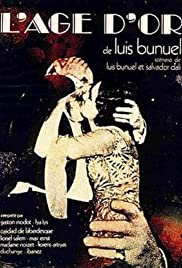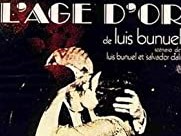L’Age d’Or ***** (1930, Gaston Modot, Lya Lys, Caridad de Laberdesque) – Classic Movie Review 10,939
Director Luis Buñuel’s still provocative, vital and amusing 1930 avant-garde Surrealist masterpiece early work L’Age d’Or [The Golden Age] intends to shock and provoke as it sends up the hypocrisies of organised religion and bourgeois society, mixing absurd humour, satirical comedy, nonsense and dark comedy into the surrealism. Running just an hour, it is Bunuel’s first feature, following his 16-minute short An Andalusian Dog (1929).
The Surrealist tale, written by Luis Buñuel and Salvador Dali, is about a seaside town couple (Gaston Modot, Lya Lys) determined to make love – though everyone wants to stop them, especially the churchmen, but also their families and bourgeois society.
Religious and right-wing protestors caused a riot during its first run, and it was banned for 50 years for its supposed blasphemy, though its attack is on what Buñuel sees as the vices of organised religion.
The classical music accompaniment draws from Mendelssohn, Mozart, Beethoven, Debussy and Wagner – and a paso-doblé by Georges Van Parys.
Dali’s Surrealist Manifesto for L’Age d’Or: ‘ My general idea, while writing the screenplay for L’Age d’Or with Buñuel, was to show in a pure straight line, the behaviour of a person who sought love midst the patriotic, humanitarian ideals and other despicable mechanisms of reality.’
Released on 28 November 1930, at the Studio 28 in Paris, the film was shown without difficulty for a few days along with the paintings of Dali, Max Ernst, Man Ray, Joan Miró and Yves Tanguy. But on December 3, members of the Patriots’ League and representatives of the Anti-Jewish League interrupted the screening by throwing violent ink at the screen, with cries of: ‘We’ll see if there are any Christians left in France!’ and ‘Death to the Jews’. The audience was forced to leave the cinema, threatened by truncheons and smoke bombs.
Thus the L’Age d’Or scandal was born, with outbursts from the far right-wing press against the film, cuts ordered by the censor, the same press turning against the latter, and heckling at local council meetings. On 12 December 1930, all existing copies were confiscated by the Commissaire de Police des Grandes Carrièrs. For 50 years L’Age d’Or was only to be seen by a few film club fanatics in clandestine projections and film club showings. It was finally re-released in France in 1981.
The film was privately exhibited at the Museum of Modern Art in New York City in 1933, and finally had its legal US premiere at the Roxie Cinema in San Francisco in November 1979.
In April 2019, a restored version was shown at the 2019 Cannes Film Festival.
Also in the cast are Caridad de Laberdesque, Lionel Salem, Max Ernst, Pierre Prévert, Jacques Brunius, Luis Buñuel and José Artigas.
© Derek Winnert 2021 Classic Movie Review 10,939
Check out more reviews on http://derekwinnert.com



